Blog Archives
What Happened Today at the Monastery?
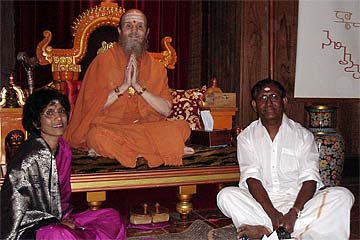
Bodhinatha with Kathirgamanathan and his wife, Sarathadevi from Newfoundland, Canada
The Ekadanta Kulam of one, Saravananathaswami gave his new today. Here a terse list of his activities.
- emailing tithe reconciliations and dealing with the responses
- update Master Course Level One course order web page
- Talking with sishyas in Malaysia by phone
- reviewing new innersearch applications
- printed Saivite Culture for our task forcers to read to read
- send out nine audio CDs for Yogaswami mahasamadhi
- setting up more group visits–Japanese spiritual tour group in June
- sent another Master Course level 2 app and vegie vrata to a serious student
- Continuing Kauai Aloha Endowment newsletter wok
- Setting up visitor arrival Calendar on our seva web wiki.

This is from today’s daily Master Course lesson. It’s such a perfect and succinct and profound summation of our tradition, we were inspired to add it to TAKA for those who do not get the daily lessons. The art shows Nandinatha, the first known guru of our lineage, with his 8 disciples in the Himalayas, where he lived over 2,200 years back. Now to Gurudeva’s delightful definition:
Natha means “lord or adept,” and sampradaya refers to a living theological tradition. The roots of this venerable heritage stretch back beyond recorded history, when awakened Natha mystics worshiped the Lord of lords, Siva, and in yogic contemplation experienced their identity in Him. The Natha Sampradaya has revealed the search for the innermost divine Self, balanced by temple worship, fueled by kundalini yoga, charted by monistic theism, illumined by a potent guru-shishya system, guided by soul-stirring scriptures and awakened by sadhana and tapas.
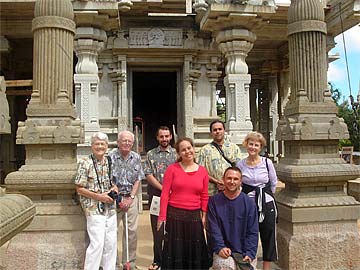
A really delightful day with soft trades and sunshine. Still, quite a number of visitors arrived, most not in our photographs since today is not an official tour day. But a few did get to visit Iraivan and here they are.
From left to right Mary Jane Dockeray and Bertrand Hewett both from Grand Rapids, Michigan. Sunny Stewart from Hilo, Hawaii, Sabrina Machado from Kauai, Rob Churney,Jr. from Suva, Fiji and J. Cienian, also from Grand Rapids, and Shen Orion from Kauai.

Sunny, Sabrina and Rob Churney in front of the sanctum. (Sabrina arranges tours on the Island).
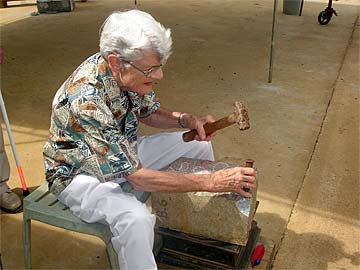
Mary Jane Dockeray, now retired and in her 80s (they came to Kauai to celebrate her husband’s 80th birthday). She told us that she was used to whacking away at stones and had done it for years in her profession as a geologist. Mary Jane hit that stone with such force and precision that a large chunk flew off one corner of the block. There was a hushed chorus of “Wow!” from all admirers present, including Silpi Chellaiya one of our professional stone-carvers who was passing by.

One last photo in front of the Iraivan Temple before departing on the people mover.
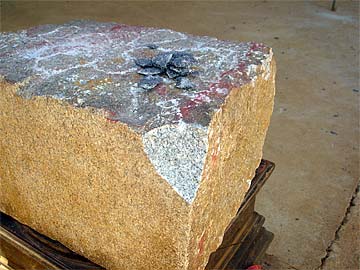
Mary Jane’s signature mark. After thousands have tried, an 80 year old finally shows how it’s done and took a big chip out of the stone!

The palmyra palm tree (Borassus flabellifer) is the “general store of the East. Flabellifer means “fan-bearing.” The fronds are amazingly convoluted and stiff. It is also known as the jaggery palm or toddy palm, can be found growing wild in tropical regions in India, Africa, Sri Lanka, Southeast Asia, and Papua New Guinea. This tree is mainly used to produce sweet sap, which is made into jaggery, or palm sugar. This sugar is used to sweeten dishes and can be distilled into wine and vinegar. It is, by far, the best brown sugar in the world. The palmyra palm also produces seeds similar to coconuts that contain a sweet fruit that is enjoyed by the people who live in regions where the palm grows. This photo is one of our, 12 years old. The photo below of older trees is from a garden in Asia.
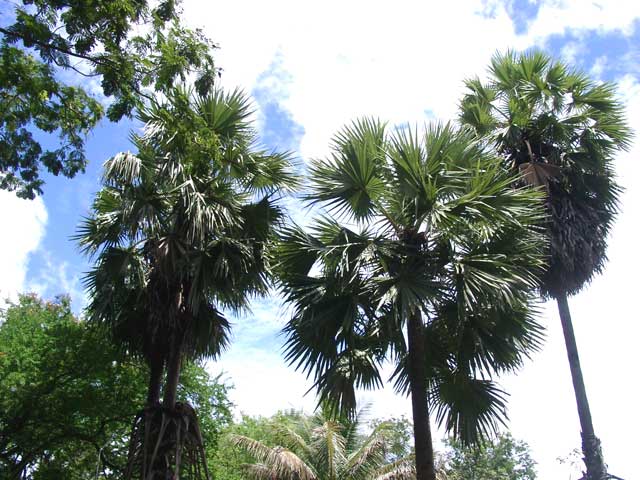
Palmyra palm seeds, also called “tag gola” and “loog than” in Thailand, are only found on female palm trees. The seeds grow in clusters on a long shoot at the top of the palm. The palm trees produce between six to twelve clusters annually, totaling about 300 individual seeds. These seeds grow to be about six to eight inches in diameter and resemble a small coconut. They are round or slightly oval with a leathery-hard brown skin that turns black when it is picked.
The fruit from both the immature and mature seeds are eaten. Both types of seeds are commonly roasted before opening the skin to reveal the fruit. Inside the immature seeds are numerous long, tough white fibers that are coated with two to four segments of yellow or orange juicy pulp. This pulp is extracted and eaten. The immature seeds also contain two or three soft white kernels that are translucent and have a crunchy texture like lychees. Inside the kernel is a sweet liquid like coconut milk that can be consumed. When the seed matures the kernel becomes opaque white like coconut meat, but is much harder and not edible. Only the pulp of mature seeds is eaten. The pulp is used in various baked and steamed desserts and the pulp from immature seeds is commonly pickled in vinegar. The juice of the fruit can also be extracted to make into a beverage or used in rice pudding dishes.
If you would like to try palmyra palm fruit, you should try looking in Indian and Southeast Asian markets. The fruit can be found canned and frozen year-round. The trees at Kauai’s HIndu Monastery, planted near Iraivan, are still young, just 12 years old, so it will be a while before they bear fruits.
From Our Gurus' Teachings
Archives are now available through 2001. Light colored days have no posts. 1998-2001 coming later.
